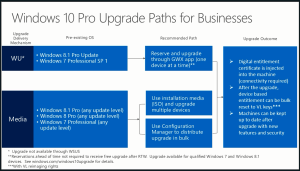

If your company has your machines connected to a WSUS server, MDM solution, or even if those machines are joined to a Domain, they will NOT automatically upgrade. IT staff will need to set a Group Policy through a new WINDOWSUPDATE.ADMX file that Microsoft has made available OR manually make an as yet unannounced registry entry to override that setting and make the Windows 10 upgrade available through Windows Update. Alternately IT staff can download the Windows 10 ISO and install Windows 10 via DVD, thumbdrive or distribution tool like System Center.
PC’s with Windows Enterprise will need to purchase an upgrade through their VAR, unless they already have Software Assurance in which case they will get it for free.
After Windows 10 is on a PC, upgrades to that Windows 10 core Operating System (which may occur several times a year) will come from both Microsoft servers AND other Windows 10 machines that already have the update in question. This will be a “Peer to Peer” distribution much like BitTorrent.
During the upgrade process, a C:\WINDOWS.OLD folder will be created which contains all of the old Windows settings so that you CAN uninstall Windows 10 and return to your old version of Windows. That folder will automatically be deleted after 30 days as part of the disk clean up routine and you will loose the ability to roll back.
This website uses cookies.